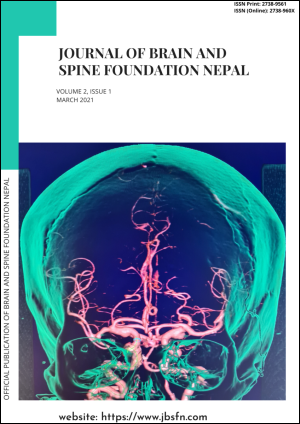Factors predicting pneumonia in patients admitted with spontaneous supratentorial intracerebral hemorrhage in western region of Nepal
DOI:
https://doi.org/10.3126/jbsfn.v2i1.39015Keywords:
Hemorrhagic stroke, Pneumonia, Intensive care unit, Risk factorsAbstract
Introduction: Despite the well-documented association of stroke-associated complications and infections with increased mortality, morbidity and worse long-term outcome, there are only limited data available on independent predictors of pneumonia in patients with acute intracerebral hemorrhage. In this study, our objective was to evaluate risk factors and comorbid conditions associated with the diagnosis of hospital acquired pneumonia in the patients admitted with spontaneous intracerebral hemorrhage and to determine the independent predictors of pneumonia in these patients.
Methods: A retrospective analysis was done in patients admitted in Intensive Care Unit of Nepalgunj Medical College with spontaneous intracerebral hemorrhage. Various clinic-demographic parameters were tested for association with pneumonia or no pneumonia group using chi square or student’s “t” test.
Results: A total of 117 patients, 86 men (73.5%) and 31 women (26.5%) with spontaneous intracerebral hemorrhage were included in the study. There were 36 (30.77%) patients with pneumonia. The association Diabetes mellitus (p<0.01), COPD (p<0.01), smoking (p<0.01), mean GCS (p<0.01), ICH volume (p=0.01), ICH score (p<0.01), operated status (p<0.01), Ganglionic (<0.01), Brain stem (p=0.03) and Ventricular (p=0.01) location of hematoma was statistically significant with pneumonia. Outcome in terms of MRS at discharge was also poorer for patients with pneumonia (p=0.01).
Conclusion: Diabetes mellitus, COPD, mean GCS, ICH volume, ICH score, operated status, higher MRS score were associated with increased risk of pneumonia in ICH. Similarly, ganglionic hematoma, brainstem hematoma and those having intraventricular hemorrhages are also associated with increased risk of pneumonia. Outcome in patients in terms of MRS were also poorer in those who had pneumonia.
Downloads
Downloads
Published
How to Cite
Issue
Section
License
Copyright (c) 2021 Subhash Yogi, Joshan Neupane, Aabishkar Bhattarai, Bijaya Karki, Benju Tilija Pun

This work is licensed under a Creative Commons Attribution 4.0 International License.

